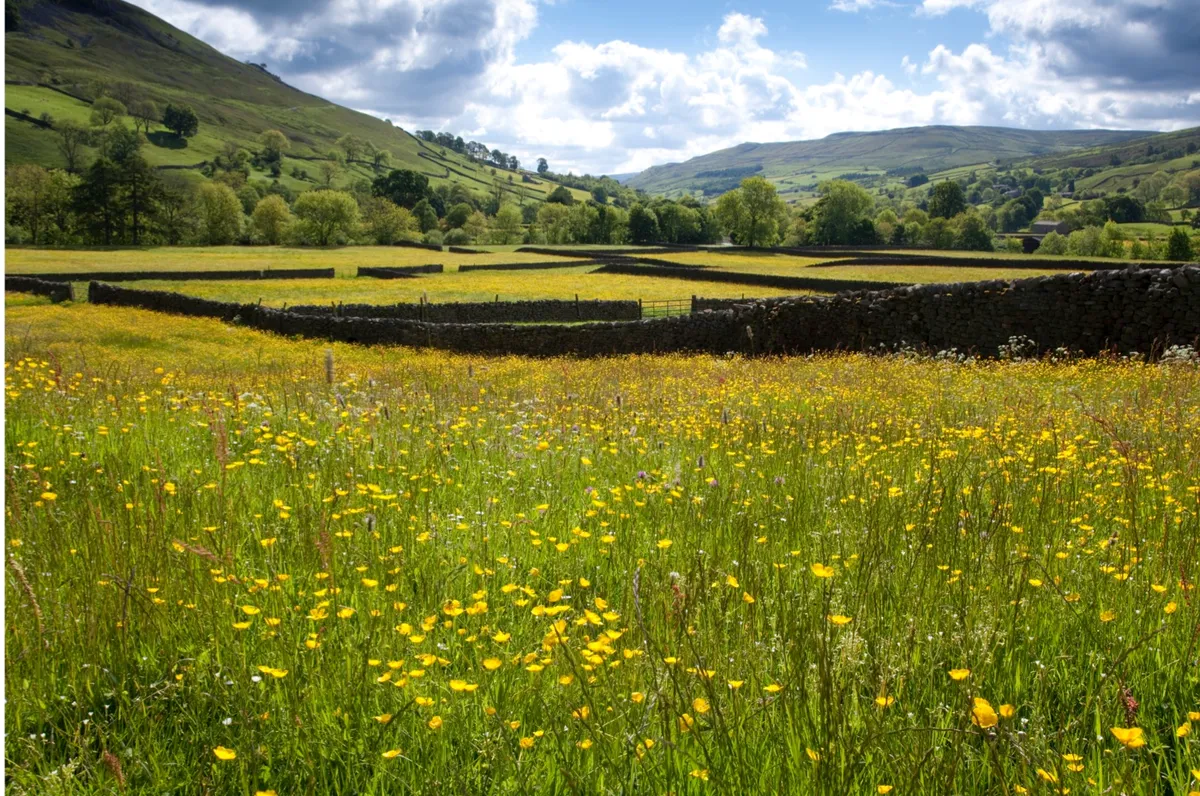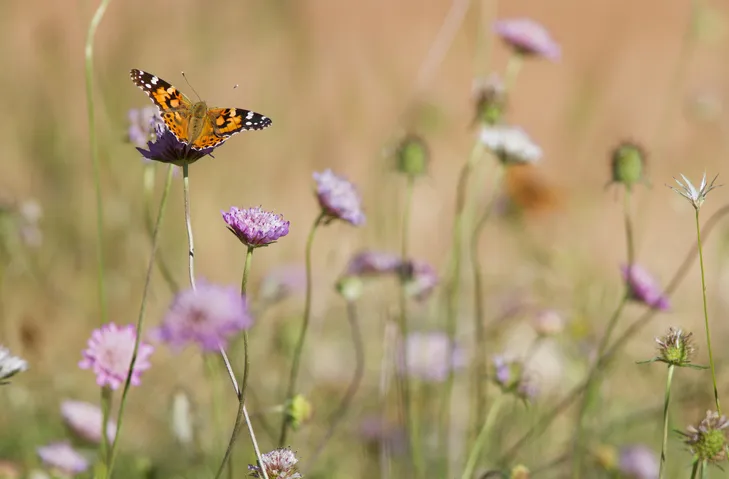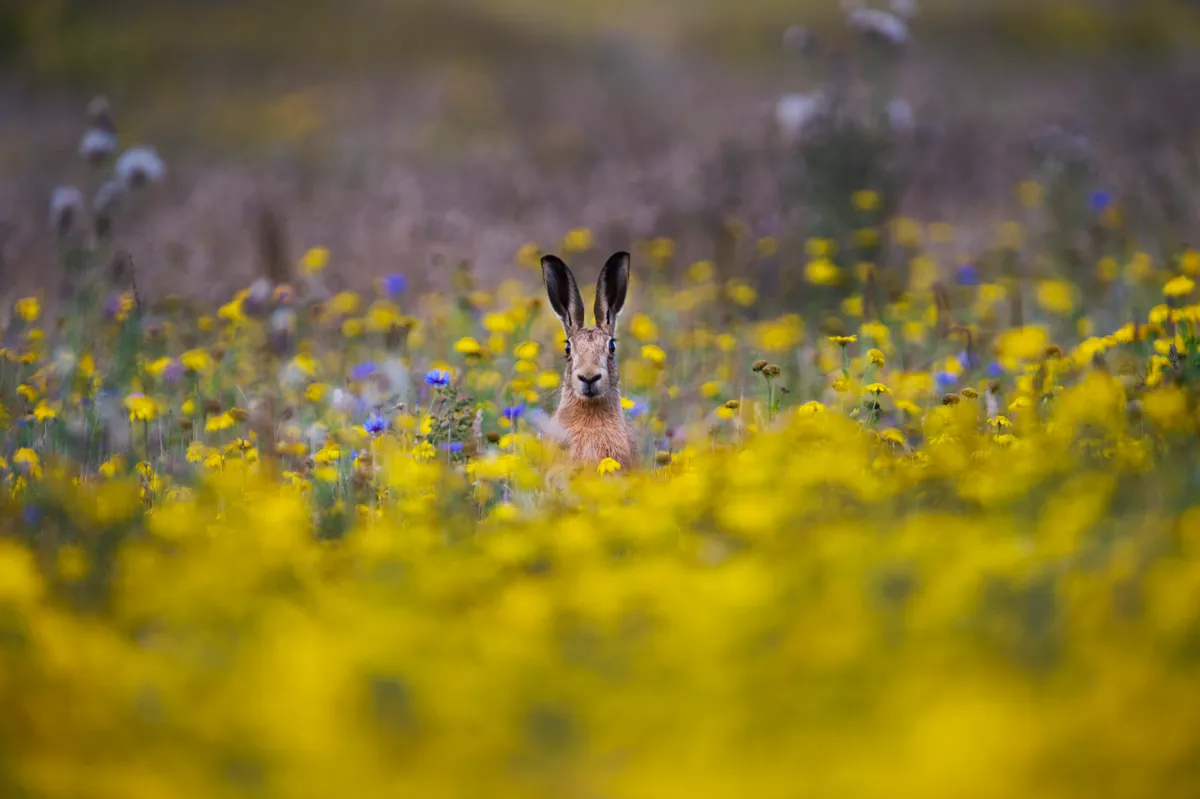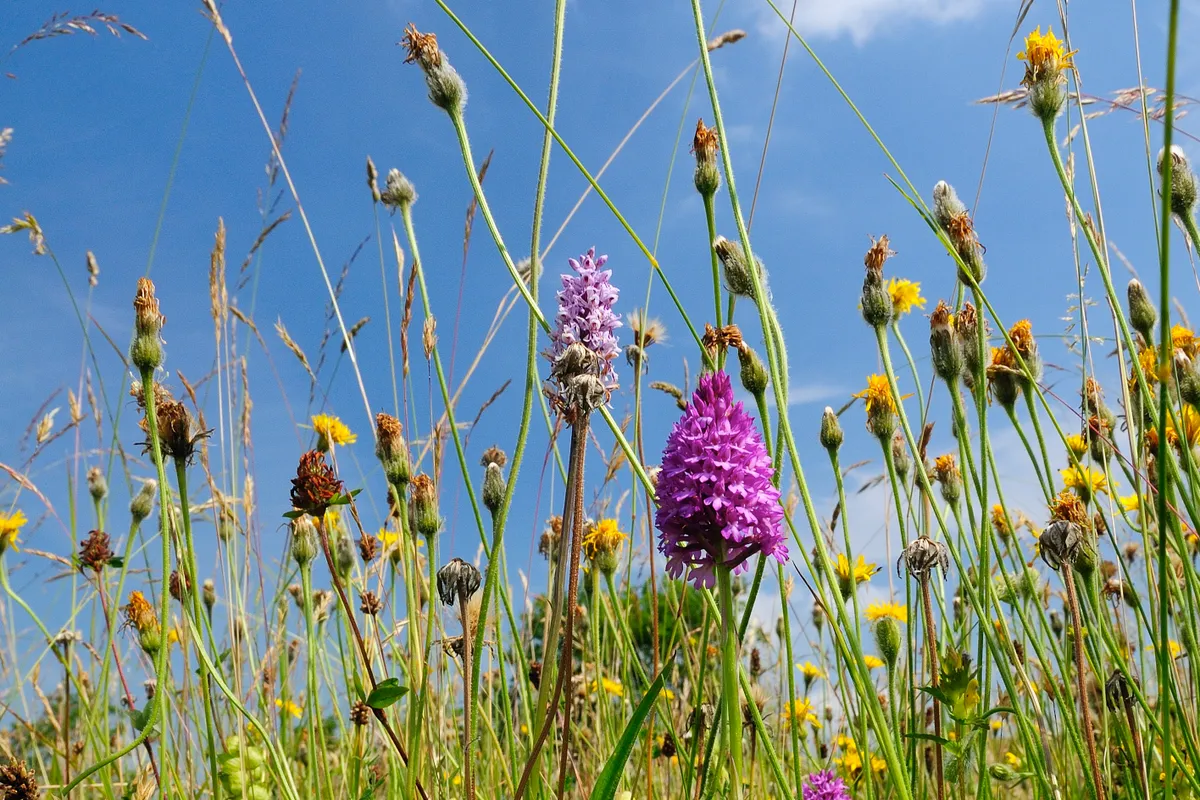There is only one way to fully appreciate the biodiversity of a hay meadow. Resist the temptation to wander through the flowers; trampling disfigures a meadow, flattens rare plants and can destroy hidden nests.
Instead, arm yourself with a good field guide, such as this one, stick close to footpaths and boundaries, and hone your wildflower identification skills. Then sit down and immerse yourself in the flowers and swaying grasses, so that you have a hare’s eye-view. Take a camera – preferably one with a macro lens with a shallow depth of focus, so you can isolate individual flowers and insects against a diffuse background – and record the activity that unfolds around you. The hours will fly by.
Here is our expert guide on meadows in the UK, revealing what hay meadows are, a brief history of British meadows, different types of meadow, when to visit, plants to look for, wildlife to spot, different grasses that grow in them, where to see the UK's most beautiful meadows and how to grow your own wildlife meadow at home.

Wildflowers blooming in Muker Meadows, Swaledale, Yorkshire ©Getty
What is a hay meadow?
Hay meadows can be home to as many as a hundred plant species, cohabiting in a delicate balance that depends on an ancient form of husbandry.
Hay cutting, followed by grazing and limited manuring, maintains a low level of soil fertility that prevents any species from becoming dominant, supporting a level of floral biodiversity that is breathtakingly beautiful. There, among the grasses, you would find the sources of that comforting fragrance: the leaves of meadowsweet, with their vaguely medicinal smell; lady’s bedstraw, with a soporific scent that led to its use in stuffing mattresses; and coumarin-scented sweet vernal grass.

Add to that a bouquet of other botanical ingredients – lady’s mantle, cranesbills, buttercups, hay rattle, scabious and clover, to name but a few – and then leave it to dry in the sun. This alchemy creates the sweetest, most fragrant bale of hay, the essence of summer.

There cannot be another agricultural crop that contributes so much to wildlife and to the rural landscape. It teems with life. At peak flowering time, these old meadows hum with bees, nectaring on clover and hay rattle flowers. Swarms of hoverflies collect pollen and moths lay their eggs among the leaves; a myriad of other insects live and breed here. They in turn provide food for swallows that skim across the fields and redstarts and wagtails that make feeding forays from the enclosing walls. Stand and watch for long enough and you’ll likely see curlews and skylarks, watch a kestrel stoop on mice and voles that scurry in the undergrowth or catch sight of the long ears of a hare among the flowers.

A brief history of hay meadows
Only about 1,000 hectares of traditional upland hay meadow remain, mostly in North Yorkshire and the North Pennines. A further 1,500 hectares of lowland meadow are scattered across the British Isles, together with a smaller area of seasonally flooded grasslands and managed water meadows that have a diverse flora. Traditional meadows that survive depend largely on financial incentives for farmers or are in the care of conservation charities.
The presence of woodland flowers such as wood cranesbill in some old grassland suggests that the origins of these flower-rich habitats can be traced back to original forest clearings, and that centuries of hay harvesting, followed by grazing with minimal nutrient input, maintained a highly diverse flora.

The ploughing of hay meadows for conversion to arable production began in earnest during the First World War, gathering pace during the Second World War. In the latter half of the 20th century, the application of artificial fertilisers in many meadows favoured vigorously growing grasses at the expense of less competitive wildflowers. More recently, reseeding with high-yielding forage grasses, which are harvested without drying to make the fermented silage fed to cattle, became an economically more attractive alternative to traditional hay-making. The latter requires at least four consecutive days of fine weather in our capricious climate.
What are the different types of meadow in the UK?
Different types of meadows support specific types of wildlife, be it plants and flowers or insects and mammals. Here are the three main varieties in the UK.
Upland hay meadows
Terrain and climate have made upland hay meadows difficult to cultivate for any other purpose, which in many cases explains their survival. Still, less than 1,000 hectares of this irreplaceable habitat remain in England – an area roughly four times the size of the London 2012 Olympic Park. Some of the finest examples are in Teesdale, Lunedale, Weardale and Baldersdale in County Durham, Swaledale (pictured above) and Wharfedale in North Yorkshire and around Tebay, Orton and Ravenstonedale in Cumbria.

After the hay cut, the meadows are usually grazed until winter and sometimes receive the lightest of applications of farmyard manure. These are places where you can find wood cranesbill, ragged robin, globe flower, adder’s tongue fern and the magical lady’s mantle.
At sunrise after humid nights, the serrated rims of lady’s mantle leaves are fringed with sparkling water droplets, once believed by alchemists to be essential for converting base metals into silver (the Latin name of this plant, Alchemilla, means ‘little alchemist’). The best time to visit upland meadows is in late June and early July.
Seasonally flooded meadows
The Domesday Book records the agricultural value of fertile seasonally flooded meadows. Unlike water meadows, which are deliberately flooded in winter to maintain fertility, these hay meadows on river flood plains depend on natural winter inundation, which favours the growth of moisture-loving wildflowers such as marsh marigold, lady’s smock and meadowsweet in spring and early summer, followed by devil’s bit scabious and greater burnet later in the year. In the rarest examples, such as Cricklade North Meadow in Wiltshire, the snakeshead fritillary still blooms in profusion in spring (pictured above).

Some seasonally flooded meadows are ancient Lammas land, which was rented out in small parcels to local farmers for the hay crop cut on Lammas Day (1 August), then used as common grazing land for the rest of the year.
Lowland meadows
Less than 15,000 hectares of lowland hay meadow remain in Britain and their distribution is highly fragmented. Some only persist as flower-rich rural road verges that are vulnerable to road-widening schemes. Many of the finest examples are on neutral or alkaline soils, where you can find lady’s bedstraw, clustered bellflower, hoary plantain and salad burnet. Rarer species include dyer’s greenweed, green-winged orchid and greater butterfly orchid.

In most flower-rich meadows there’s also a fine display of yellow rattle, a pretty parasitic flowering plant that attaches itself to the roots of rampant grasses, weakening their growth and so assisting other, less competitive wildflowers.
Late June is often the best time to visit lowland meadows and notable locations are in Worcestershire, Somerset, Dorset, Wiltshire, Leicestershire, Northamptonshire, Cambridgeshire and Suffolk, Brecknock in Powys, and west Fermanagh.
Finally, the coastal machair vegetation, farmed by crofters in Scotland’s Western Isles, grows on soil enriched with wind-blown shell sand that neutralises the acidity of underlying peat and so includes a spectacular array of wildflowers, as well as providing habitat for the endangered corncrake.
When is the best time to see hay meadows?
Many look lovely in spring but the best time to visit is probably just before the hay-cut in the second half of July.
If you can, go back when the new-mown hay is left in windrows (long rows), drying in the sun. The scent of coumarin (particularly strong in drying grass) is unforgettable. At least one agricultural show, at Eggleston in Teesdale, County Durham, still has a competition where farmers can enter “a bale of hay from old land”. It’s wonderful stuff.
Hay meadow field guide
Here is some of the species of flowers, grasses and animals that can be found in a typical UK hay meadow.

What are the top plant species found in hay meadows?
1. Hay rattle
A parasite on grass roots that steals their nutrients and reduces their vigour, helping surrounding wild flowers to compete successfully. Traditionally, hay making begins when its dry seed pods rattle.
For a fuller list, see our guide to Parasitic plants of the British Meadows.
2. Meadow saxifrage
One of the first species to flower, meadow saxifrage produces porcelain-white flowers on long stems. It dies down quickly after flowering, leaving tiny buds called bulbils that will begin growth again in early March.
3. Wood cranesbill
It’s the first large-flowered cranesbill to bloom, followed by paler blue meadow cranesbill. Both have beaked fruits that catapult seeds into surrounding vegetation.
4. Greater butterfly orchid

Old meadows are home to the greater butterfly orchid, whose pale flowers are pollinated by night-flying moths that are attracted by its scent. Nectar is hidden in a long, slender spur, only accessible with a long proboscis.
5. Ragged robin
Identifiable by its frayed flowers and narrow leaves, ragged robin can be easily grown in moist soil.
6. Meadowsweet
Hardy meadowsweet is named for its fresh and distinctive scent. The edible wildflower is also known for its healing properties, once used as a herbal pain-reliever.
7. Globe flower

The globe floweris similar to a buttercup in appearance, and thrives best in cool alpine regions.
8. Melancholy thistle
Tall, moisture-loving Melancholy thistle produce lush growth in moist hollows, while low-growing species favour higher, drier hummocks.
Insects, mammals and birds to spot in meadows
1. Mole hill
The freshly excavated earth of a mole hill provides perfect conditions for seed germination.
2. Swallow

Hungry swallows swoop low over the flowers and grasses on summer days, feeding on the abundance of insects that feed and breed on the wealth of plant species in a meadow.
3. Chimney sweeper moth
The day-flying chimney sweeper moth is a common sight in North Pennine meadows, where its caterpillars feed on pignut.
4. Shipton moth
The wing markings of the Shipton moth resemble a witch’s face.
5. Meadow brown butterfly
Hay meadow grasses are important food for several butterfly caterpillars. Larvae of the meadow brown butterfly feed on fine leaves of fescues and bents.
6. Meadow and common green grasshoppers

These grass hoppers hatch in April and go through four nymphal stages before becoming winged adults in early July, just in time to escape the mower. Their chirruping is the music of a drowsy summer afternoon.
6. Large Skipper
Large skipper butterflies produce larvae that eat the coarser foliage of cock’s-foot grass.
7. White-tailed bumblebee
Meadows are a particularly good source of nectar and pollen for hard-pressed bumblebee species such as the white-tailed bumblebee. Burrows of small mammals around field edges provide nest sites.
Common hay meadow grasses
1. Crested dog’s tail Cynosaurus cristatus
This hardy grass has a flattened, spiked inflorescence, the florets of which dangle their stamens towards one side. Its flower stems, which were formally used to make straw hats, become tough and unpalatable so persist late into the year on grazing land.
2. Cock’s-foot Dactylis glomerata
A robust, tussocky grass with flattened vegetative shoots. Its one-sided, dense spikelets are clustered on three or four branches, likening its outline to a chicken’s foot. An important contributor to the hay crop, cock’s foot also occurs in many other grassy habitats.
3. Yorkshire fog Holcus lanatus

This major component of hay meadows has a prolific seed output that rapidly colonises bare soil patches. The softly, hairy inflorescences have a delicate red tinge, so dense populations of this grass look like a pink mist on a summer evening.
4. Common bent Agrostis tenuis
Beginning to flower in late June, this fine-leaved grass competes best in drier parts of meadows, on poorer acid soil. It is also known as brown top, because its airy, open flower panicles resemble a brownish-purple haze. It’s widely cultivated for high quality lawns.
5. Meadow foxtail Alopecurus pratensis
This begins growth early in spring and its distinctive cylindrical inflorescences bloom in mid-May, much earlier than the similar Timothy grass. It is at its most impressive in moist, fertile soils of water meadows, where its flowering stems may reach one metre tall.
6. Quaking grass Briza media
Heart-shaped spikelets dangle from slender stems and tremble in the slightest breeze, a characteristic that is reflected in quaking grass’s local names like cow quakes, doddering dillies, shivering and totter grass. It favours dry, calcareous grassland and is soon lost when this is ‘improved’ with added fertiliser.
7. Sweet vernal grass Anthoxanthum odoratum
One of the earliest grasses to flower, often in April, sweet vernal grass thrives in acid soils in upland meadows. It contains high levels of coumarin, which
is responsible for the intense new-mown hay fragrance of a freshly mown meadow. Its inflorescences ripen to a golden-yellow in summer.
8. Soft-brome Bromus hordaceus
An annual species, flowering mid-May onwards, with soft, hairy stems and leaves. Also known as lop grass. The flowering panicle is erect at first but the spikelets soon nod once seeds begin to form. Common in a wide range of grassy situations.
9. False oat grass Arrhenatherum elatius
A species of coarse flowery grassland, often alongside meadow sweet and hogweed in rough pastures. Its broad leaves and tall flowering culms are conspicuous from a distance. The bristle-like awn, protruding from the flower spikelet, has a distinctive knee-bend.
Best places to see hay meadows in the UK
There are plenty of wonderful hay meadows that come into their own in late spring and early summer. Here is our guide on where to go, with website details.

Caeau Tan y Bwlch Nature Reserve, Gwynedd
Hunt for the greater butterfly-orchid and enjoy the coastal views, too. northwaleswildlifetrust.org.uk/nature-reserves/caeau-tan-y-bwlch-nature-reserve
Sylvia’s Meadow, Cornwall
Formerly a Second World War army base, now home to lesser butterfly-orchids. cornwallwildlifetrust.org.uk/nature-reserves/sylvias-meadow
Saltbox Hill SSSI, Bromley
In easy reach of London, this chalk meadow is home to at least 32 butterfly species, such as the chalkhill blue. wildlondon.org.uk/nature-reserves/saltbox-hill-sssi
Muker Meadows, North Yorkshire
Find globeflowers and melancholy thistles at these stunning upland hay meadows. yorkshiredales.org.uk/about/wildlife/places-to-see-wildlife/muker-meadows/
Jupiter Urban Wildlife Centre, Falkirk
Meadows created from industrial wasteland in Grangemouth are home to orchids and wetland species including dragonflies. scottishwildlifetrust.org.uk/reserve/jupiter-urban-wildlife-centre/
Slievenacloy Nature Reserve, County Antrim
An extensive area of grassland rich in butterflies, moths and birds. ulsterwildlife.org/nature-reserves/slievenacloy
Cremer’s Meadow, Norfolk
This low-lying site is a great place to see southern marsh orchids. norfolkwildlifetrust.org.uk/wildlife-in-norfolk/
Hawthorn Dene meadows, Durham Coast
A species-rich coastal meadow, set on magnesian limestone cliffs on the Durham coast. It becomes a tapestry of cowslips, lady’s bedstraw, spotted orchids and cranesbills, followed by field scabious, hemp agrimony, knapweed and meadowsweet as summer progresses. durhamwt.com
Lugg Meadow, near Hereford, Herefordshire
These flood meadows, recorded in the Domesday book, are noted for their snake’s-head fritillaries. The land is divided into small parcels, owned by local families who each cut their own hay crop. plantlife.org.uk
Yellands Meadow Nature Reserve, Muker, North Yorkshire
On the banks of the river Swale, this reserve forms part of the Muker Meadows Site of Special Scientific Interest in Swaledale. Classic hay meadow flora is managed in a traditional way over many generations, in stunning scenery. ywt.org.uk
Marden Meadow, Cranbrook, Kent
The finest remaining hay meadows in Kent are noted for their display of green-winged orchids in spring and riot of hay meadow flowers in summer. kentwildlifetrust.org.uk
Willoughby Meadow, Alford, Lincolnshire
This small meadow is home to 149 plant species, including great burnet, adder’s tongue fern, saw-wort and devil’s-bit scabious. lincstrust.org.uk
Greena Moor, Cornwall
Greena Moor near the village of Week St. Mary is one of the last remaining areas of culm grassland in North Cornwall. This distinctive habitat hosts a wide range of flora, especially those adapted to thrive in waterlogged conditions. Species to spot include; ragged-robin and whorled caraway. wildlifetrusts.org/reserves/greena-moor-creddacott-meadows
Hartington Meadow, Derbyshire
Throughout summer the meadows of Hartington are bursting with the colour of wildflowers. The grasslands are managed as part of a working farm and regular hay cutting encourages a huge variety of plants. A disused limestone quarry also provides the ideal environment for various orchid species and even some cliff-nesting birds. derbyshirewildlifetrust.org.uk/reserves/hartington-meadows
Muker Meadow, Yorkshire Dales
The Muker area offers one of the best examples of upland hay meadows and was named one of the sixty ‘coronation meadows’ by HRH the Prince of Wales in 2013. All the meadows are rich in wildflowers and grasses, and some of the species even provide the donor stock for land restoration projects in the area. Interesting flora to look out for include the Pignut, Lady’s Mantles and Melancholy Thistle. ydmt.org/meadow-details-muker-swaledale-16142
Stockings Meadow, Herefordshire
Previously this meadow was woodland that was cleared for agriculture, leaving the land covered in tree stumps or ‘stocks’. Today, there is a great diversity of floral species in both the meadow and old hedgerows that surround it. The common spotted orchid and heath orchid can be seen here, but if you’re lucky you might spot a hybrid of the two. wildlifetrusts.org/reserves/stockings-meadow
How to create your own meadow and best wildflowers to plant
Planting wildflowers to create your own meadow, however tiny, is a brilliant thing to do for wildlife. Urban meadows are more important than ever and depending on the size of your garden can be planted in a section of your lawn, borders or even in planters. Most good garden centres sell mixed wildflower seed packets with species such as cornflower, poppy, corn marigold, wild marjoram etc. which will soon attract bees and butterflies.
If you have grass, try to let it grow a little more than usual – aiming to mow no more than once a month. Longer grass will allow wildflowers to thrive. Wildflower seeds can be scattered along the edge of your lawn or if you have a patch of bare soil scattered and lightly raked into the earth. Water well.
You can also create a mini meadow using pots or containers. Simply lightly scatter your seeds, rake over and water well.
